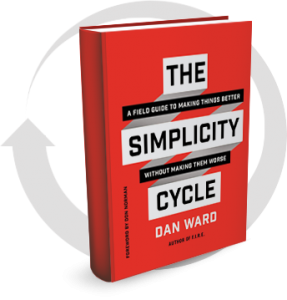 Where did the idea for The Simplicity Cycle originally come from? Well, let me tell you.
Where did the idea for The Simplicity Cycle originally come from? Well, let me tell you.
The year was 2002. I was a young Captain in the Air Force, assigned to an intelligence agency in Washington DC. My duties includes serving as program manager for a little imagery system called BRITE, and sometimes I got to give demos of BRITE to potential users.
One day as I was about to begin a demo for a Navy Lieutenant Commander, she held up her hand and spoke two sentences that blew my mind and changed my life forever. She said:
“I don’t care how good this system is. If it isn’t easy to use, I don’t want it.”
Whoa. That was basically the opposite of what everyone around me was saying (i.e. we don’t care how easy it is to use, as long as it has all the latest cutting edge gadgets & features). If a system or process was hard to use, no problem at all. Just give the users more training. Problem solved. But she was saying ease of use mattered more than performance?
Mind. Blown.
I actually wrote down those two sentences (and yes, BRITE was easy to use, she did like it, and her unit used it quite successfully thankyouverymuch). I continued thinking about what she said over the next few weeks… and months… and years. Her words rang in my ears and wouldn’t let go of my imagination. So I began an informal investigation into the relationship between complexity, ease of use, goodness, and design. I had no idea where it would all lead, but I knew it was a path worth exploring.
I guess the first lesson is to pay attention. Listen to people who are saying the opposite of what everyone else is saying. Listen to the complaints, the pain points, the alternative views. Carry a little notebook and write these things down. And then pick one to investigate. It’s OK if you don’t know where the path ends. Check it out and see what happens. Who knows – you might end up with a book someday (13 years later).
NEXT WEEK: The Simplicity Cycle Meets The World